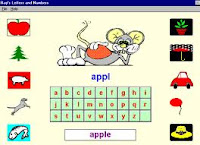In a broader sense, the term edutainment describes an intentional merger of computer games and educational software into a single product (and could therefore also comprise more serious titles described above under children’s learning software). In the narrower sense used here, the term describes educational software which is primarily about entertainment, but tends to educate as well and sells itself partly under the educational umbrella.
Software of this kind is not structured towards school curricula, does not normally involve educational advisors, and does not focus on core skills such as literacy and numeracy.
manufacturers, including many established educational book publishers.
Educational software on custom platforms
Educational software on custom platforms
Some manufacturers regarded normal personal computers as an inappropriate platform for learning software for younger children and produced custom child-friendly pieces of hardware instead. The hardware and software is generally combined into a single product, such as a child laptop-lookalike. The laptop keyboard for younger children follows an alphabetic order and the qwerty order for the older ones.
The most well-known example are Leapfrog products. These include imaginatively designed hand-held consoles with a variety of pluggable educational game cartridges and book-like electronic devices into which a variety of electronic books can be loaded. These products are more portable than general laptop computers, but have a much more limited range of purposes, concentrating on [[literacy]
Software in corporate training and tertiary education
Earlier educational software for the important corporate and tertiary education markets was designed to run on a single desktop computer (or an equivalent user device). The history of such software is usefully summarized in the SCORM 2004 2nd edition Overview (section 1.3), unfortunately, however, without precise dates. In the years immediately following 2000, planners decided to switch to server-based applications with a high degree of standardization.
This means that educational software runs primarily on servers which may be hundreds or thousands of miles from the actual user. The user only receives tiny pieces of a learning module or test, fed over the internet one by one. The server software decides on what learning material to distribute, collects results and displays progress to teaching staff. Another way of expressing this change is to say that educational software morphed into an online educational service. US Governmental endorsements and approval systems ensured the rapid switch to the new way of managing and distributing learning material.



















